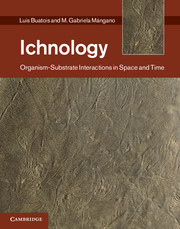Book contents
- Frontmatter
- Contents
- Acknowledgments
- Introduction
- Part I Conceptual tools and methods
- Part II Spatial trends
- 6 Trace fossils and paleoecology
- 7 Ichnology of shallow-marine clastic environments
- 8 Ichnology of marginal-marine environments
- 9 Ichnology of deep-marine clastic environments
- 10 Ichnology of continental environments
- 11 Ichnology of carbonate environments, rocky shorelines, and volcanic terrains
- Part III A matter of time
- References
- Index
6 - Trace fossils and paleoecology
from Part II - Spatial trends
Published online by Cambridge University Press: 25 October 2011
- Frontmatter
- Contents
- Acknowledgments
- Introduction
- Part I Conceptual tools and methods
- Part II Spatial trends
- 6 Trace fossils and paleoecology
- 7 Ichnology of shallow-marine clastic environments
- 8 Ichnology of marginal-marine environments
- 9 Ichnology of deep-marine clastic environments
- 10 Ichnology of continental environments
- 11 Ichnology of carbonate environments, rocky shorelines, and volcanic terrains
- Part III A matter of time
- References
- Index
Summary
Decían que había como mil pichis escondidos en la tierra, ¡enterrados! Que tenían de todo: comida, todo. Muchos decían tener ganas de hacerse pichis cada vez que se venían los Harrier soltando cohetes.
Rodolfo Foghill Los Pichiciegos (1994)Organisms burrow in response to many biotic and environmental factors. Ichnological studies provide detailed information on environmental parameters involved during sediment deposition and, therefore, serve as a basis for sedimentary environment and facies analysis. To that end, ichnological analysis should focus on the paleoecological aspects of trace-fossil associations (e.g. ethology, feeding strategies, ichnodiversity) and should avoid the simple use of a checklist approach because this may lead to paleoenvironmental misinterpretations. The paleoecological approach needs to be integrated with facies analysis, and should never aim to replace it. Many factors define the niche and survival range of animal species. However, the key to the analysis is the identification of major control factors, which are called limiting factors (Brenchley and Harper, 1998). In this chapter, we revise the response of benthic organisms to different environmental parameters, evaluate the role of taphonomy, and address a set of concepts that should be employed in paleoecological analysis of trace fossils, such as ichnodiversity and ichnodisparity, population strategies, and the notion of resident and colonization ichnofaunas. Then, based on the concept of ecosystem engineering, we discuss how organisms affect the environment. Finally, we address what biogenic structures can tell us about organism–organism interactions and spatial heterogeneity.
- Type
- Chapter
- Information
- IchnologyOrganism-Substrate Interactions in Space and Time, pp. 99 - 125Publisher: Cambridge University PressPrint publication year: 2011
- 1
- Cited by

